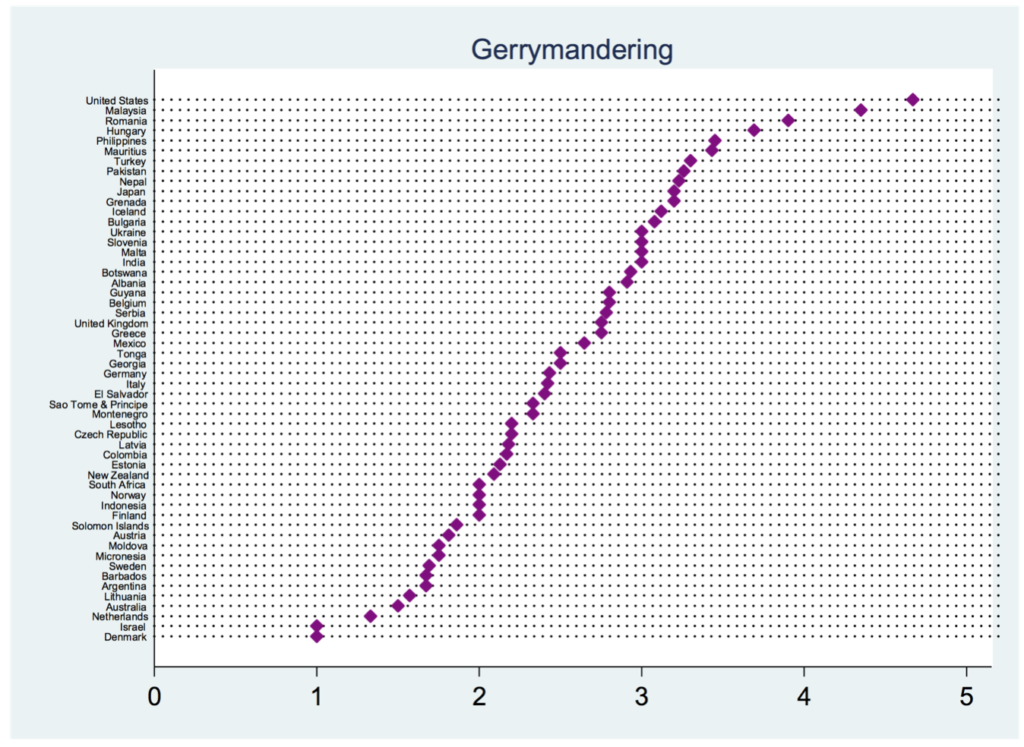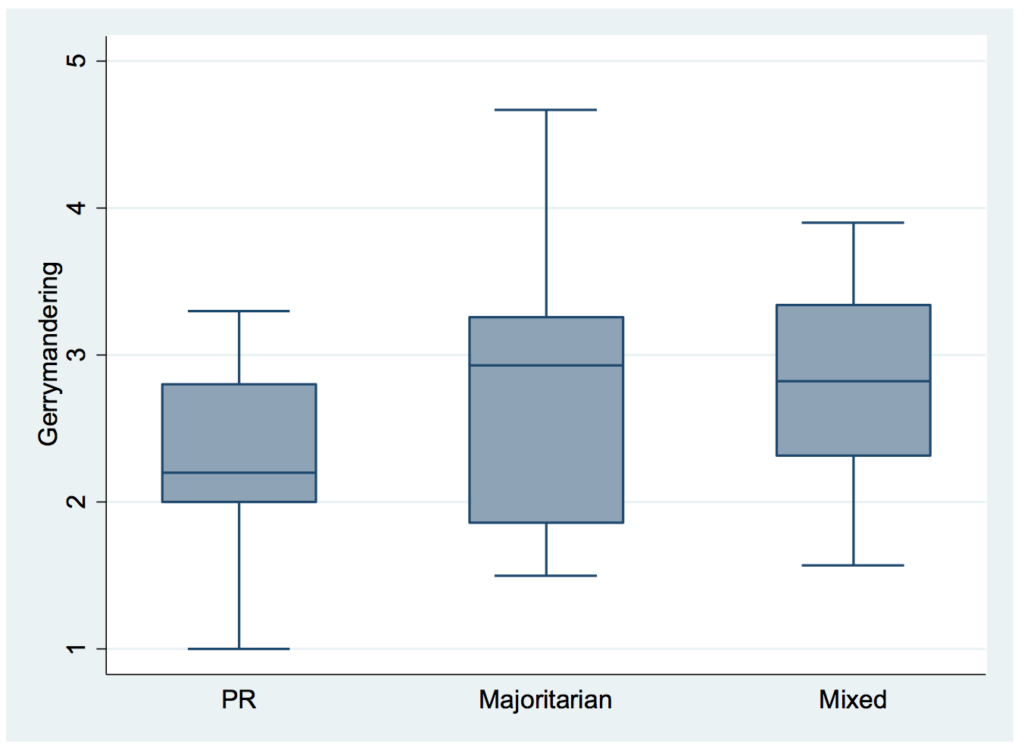Majoritarian electoral systems are more prone to gerrymandering than proportional systems
Gerrymandering, the practice of redrawing electoral boundaries in order to benefit one or more electoral actor, has a long and infamous history. Here, Ferran Martinez i Coma and Ignacio Lago look at the under-explored area of gerrymandering in a comparative perspective and what link there is between its prevelence and the electoral system in use, finding it more likely to take place in majoritarian systems such as First Past the Post – the system used in UK General Elections.

The US House of Representatives (Public Domain image)
In democracies which utilise small electoral districts, parties face an incentive to redraw district lines to achieve partisan advantage. This practice is known as gerrymandering and it is a long-standing practice in electoral democracies with very well-known normative and political implications. The goal of gerrymandering is to make one party’s votes more effective than another’s by constructing the electoral map so that the districts either submerge or pack the voters of the other party. From a normative point of view, when (re)districting creates population deviations across districts to benefit one party or the other, the ‘one person, one vote’ principle is violated. All else equal, the value of a vote is greater in those districts which are underrepresented than in the overrepresented ones.
We know less, however, on the differences in gerrymandering across countries. Are majoritarian systems more prone to gerrymandering than PR and/or mixed systems? To what extent a large legislature matters for gerrymandering?; Does the age of the electoral system affects gerrymandering?
Unfortunately, comparative studies about the levels and determinants of gerrymandering are virtually nonexistent. This is largely due to the lack of an aggregated measure that travels cross-nationally. Measuring gerrymandering is particularly problematic because it demands a very long panel of elections in the same country – making the exercise essentially meaningless for most systems because of changes in the party system- and it produces estimates that are hardly comparable across elections.
In a recent article in Party Politics, we address the above questions by providing a comparative measure of gerrymandering. The measure is based on the data collected by the Electoral Integrity Project (EIP) and covers 54 Lower House elections held from the July of 2012 until June of 2015. The measure is derived from country domestic and international election experts who were asked to evaluate whether national parliamentary elections met international standards during the pre-election period, the campaign, polling day, and its aftermath –see a previous post on expert surveys here. The measure captures whether district boundaries are considered impartial on a scale going from 1 (strongly agree, that is, no gerrymandering at all) to 5 (strongly disagree, i.e. maximum gerrymandering).
The values of gerrymandering in the countries of our study are shown in Figure 1. As can be seen, there are significant differences across countries. Not surprisingly, countries using PR with large or single national districts, Israel, the Netherlands, or Norway, have the lowest scores, while the United States and Malaysia, using majoritarian electoral system, are, by far, the countries with the least impartial district boundaries.
Figure 1: Gerrymandering across countries

Are majoritarian systems are more prone to gerrymandering than PR and mixed systems? Not all electoral systems are equally prone to gerrymandering for two reasons. First, in PR systems, it is harder to predict the exact seat distribution in every district due to the higher number of parties in the race and the smaller percentages separating winners from losers. Second, in PR systems, districts often coincide with well-known local government units or groups of these. For example, in post-communist countries, nearly all countries with PR and multimember districts employ the existing administrative territorial divisions as electoral districts. Hence, gerrymandering should be higher in majoritarian than in PR systems, as figure 2 shows.
Figure 2: the relationship between gerrymandering and electoral system type

Figure 2 shows the relationship between gerrymandering and the electoral system employed in every country Countries using PR systems score lower (2.27) than those with mixed-member (2.83) and majoritarian (2.84) systems. The differences between PR and mixed and majoritarian systems are statistically significant.
To what extent a large legislature matters for gerrymandering? The partisan advantage that can be achieved through gerrymandering when using majoritarian institutions should be greater in larger countries (in thousands of km2) for at least two reasons. First, assembly sizes are positively correlated with the size of the country (as shown by Taagepera and Shugart, 1989). Second, heterogeneity of preferences increases with size: as countries become larger, diversity of preferences, culture, language, and identity of their population increases. A large legislature and diverse preferences within countries give greater potential for gerrymandering. Our results, point out that majoritarian institutions in large countries exacerbate gerrymandering.
Does the age of the electoral system affects gerrymandering? The age of the electoral system could condition the capacity of ruling parties to create partisan biases. When drawing electoral boundaries, the margin of ruling parties to maneuver to their advantage depends on their capacity to anticipate the results under different rules of the game. According to Popescu and Toka (2008), gerrymandering was not a prominent feature of any delimitation in the 1990s in Eastern and Central Europe, due to the shifting partisan alliances and the uncertainty about the geographic distribution of electoral support for the various parties. Therefore, on the one hand, it could be expected that the more time a country has been using the same electoral system, the less impartial the district boundaries will be. However, on the other hand, as electoral democracy is an iterated game in which parties alternate in government, a plausible focal point for parties is a non-gerrymandered electoral system. Accordingly, partisan gerrymandering should be less relevant as times goes by. The results do not find support for such claim.
To sum up, many studies have devoted attention to examining gerrymandering, particularly in the United States. However, we do not know much about gerrymandering in a comparative perspective. Relying on election experts, we show that majoritarian systems are more prone to gerrymandering than mixed-member and above all PR systems. Furthermore, when majoritarian systems are employed in large countries, gerrymandering is exacerbated but per capita GDP and the age of electoral systems do not significantly affect gerrymandering.
Our work should be taken as a first step in investigating the determinants of gerrymandering as it remains to be further theorised and explored.
—
Note: this post represents the views of the authors and not those of Democratic Audit or the LSE. Please read our comments policy before posting.
—
Ferran Martinez i Coma is a Research Associate at the Electoral Integrity Project at the University of Sydney. He served as Senior Adviser to the Spanish Prime Minister (2010-2011). He has published in European Journal of Political Research, Electoral Studies, or Party Politics. His research interests include political behaviour, party politics and electoral integrity.
Ignacio Lago is Associate Professor of Political Science at Universitat Pompeu Fabra (Barcelona, Spain). His research interests include electoral systems, political behavior, and party politics. He has published in Public Opinion Quarterly, European Journal of Political Economy, European Journal of Political Research, Electoral Studies, or Social Science Quarterly.





 Democratic Audit's core funding is provided by the Joseph Rowntree Charitable Trust. Additional funding is provided by the London School of Economics.
Democratic Audit's core funding is provided by the Joseph Rowntree Charitable Trust. Additional funding is provided by the London School of Economics.
Majoritarian electoral systems are more prone to gerrymandering than proportional systems https://t.co/cWE01qzlrd
Majoritarian electoral systems are more prone to gerrymandering than proportional systems https://t.co/DoKSyGRAYN
There’s a blog post that explains the mathematics of this: “The Mathematics of Gerrymandering: Why is it Possible?”
https://autoredistrict.org/news.php#math_gerrymander
Majoritarian electoral systems are more prone to gerrymandering than proportional systems https://t.co/FfZjvlHFKf
Majoritarian electoral systems are more prone to gerrymandering than proportional systems https://t.co/6oRanlohF0
Majoritarian electoral systems are more prone to gerrymandering than proportional systems https://t.co/geYQylvBHD
Majoritarian electoral systems are more prone to gerrymandering than proportional systems https://t.co/mJVJlmxrON
Majoritarian electoral systems are more prone to gerrymandering than proportional systems https://t.co/y5ktGnoiTV https://t.co/1gO880YSIF